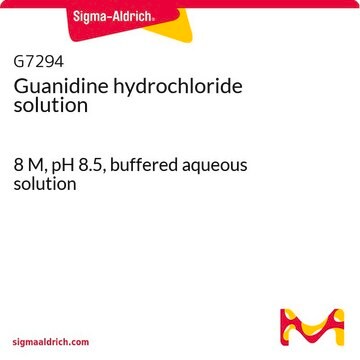Products may be shipped at a different temperature than the recommended long-term storage temperature. If the product quality is sensitive to short-term exposure to conditions other than the recommended long-term storage, it will be shipped on wet or dry-ice. If the product quality is NOT affected by short-term exposure to conditions other than the recommended long-term storage, it will be shipped at ambient temperature. As shipping routes are configured for minimum transit times, shipping at ambient temperature helps control shipping costs for our customers. For more information, please refer to the Storage and Transport Conditions document: https://www.sigmaaldrich.com/deepweb/assets/sigmaaldrich/marketing/global/documents/316/622/storage-transport-conditions-mk.pdf
G4505
Guanidine hydrochloride
organic base and chaeotropic agent, ≥99% (titration)
Synonym(s):
Guanidium Chloride, Aminoformamidine hydrochloride, Aminomethanamidine hydrochloride, Guanidinium chloride
Select a Size
Select a Size
About This Item
Recommended Products
biological source
synthetic (organic)
Quality Level
Assay
≥99% (titration)
form
crystalline powder
technique(s)
RNA extraction: suitable
impurities
≤0.3% water (Karl Fischer)
color
white
pH
(25 °C, 4.6 - 6 at 573 g/L)
mp
180-185 °C (lit.)
solubility
H2O: 6 M
density
1.3 g/cm3 (lit.)
absorption
≤0.10 at 260 nm in H2O at 6 M
SMILES string
Cl[H].NC(N)=N
InChI
1S/CH5N3.ClH/c2-1(3)4;/h(H5,2,3,4);1H
InChI key
PJJJBBJSCAKJQF-UHFFFAOYSA-N
Gene Information
human ... KCNA1(3736) , KCNA10(3744) , KCNA2(3737) , KCNA3(3738) , KCNA4(3739) , KCNA5(3741) , KCNA6(3742) , KCNA7(3743) , KCNB1(3745) , KCNB2(9312) , KCNC1(3746) , KCNC2(3747) , KCNC3(3748) , KCNC4(3749) , KCND1(3750) , KCND2(3751) , KCND3(3752) , KCNF1(3754) , KCNG1(3755) , KCNG2(26251) , KCNG3(170850) , KCNG4(93107) , KCNH1(3756) , KCNH2(3757) , KCNH3(23416) , KCNH4(23415) , KCNH5(27133) , KCNH6(81033) , KCNH7(90134) , KCNH8(131096) , KCNQ1(3784) , KCNQ2(3785) , KCNQ3(3786) , KCNQ4(9132) , KCNQ5(56479) , KCNS1(3787) , KCNS2(3788) , KCNS3(3790) , KCNV1(27012) , KCNV2(169522)
Looking for similar products? Visit Product Comparison Guide
General description
Application
- to perform absolute quantitation of amyloid-beta (Aß) isoforms in plasma[1]
- in protein carbonylation assay[2]
- for the quantification of glycosaminoglycans (GAG)[3]
- for denaturation of cow′s milk allergens[4]
- as a control in antiviral screening tests with coxsackievirus B3 (CVB3)[5]
- in RNA isolation to dissociate nucleoproteins and inhibit RNase
Biochem/physiol Actions
Features and Benefits
- Suitable for Biochemical and Cell Biology research
- Ideal for RNA extraction
- High purity product for research applications
Packaging
Each kit contains 3 x 100G samples, each sample from a uniquely manufactured lot.
Caution
Preparation Note
The maximum solubility of guanidine hydrochloride in water at room temperature is approximately 6M.
Other Notes
Legal Information
also commonly purchased with this product
related product
Signal Word
Warning
Hazard Statements
Precautionary Statements
Hazard Classifications
Acute Tox. 4 Inhalation - Acute Tox. 4 Oral - Eye Irrit. 2 - Skin Irrit. 2
Storage Class Code
11 - Combustible Solids
WGK
WGK 1
Flash Point(F)
Not applicable
Flash Point(C)
Not applicable
Personal Protective Equipment
Choose from one of the most recent versions:
Certificates of Analysis (COA)
Don't see the Right Version?
If you require a particular version, you can look up a specific certificate by the Lot or Batch number.
Already Own This Product?
Find documentation for the products that you have recently purchased in the Document Library.
Customers Also Viewed
Articles
Learn about UHPLC-MS analysis of trastuzumab on a BIOshell™ 160A peptide C18 column and discover reduced solvent consumption in peptide mapping using 1.5 mm I.D. columns.
-
How is shipping temperature determined? And how is it related to the product storage temperature?
1 answer-
Helpful?
-
-
How can I determine the shelf life / expiration / retest date of this product?
1 answer-
If this product has an expiration or retest date, it will be shown on the Certificate of Analysis (COA, CofA). If there is no retest or expiration date listed on the product's COA, we do not have suitable stability data to determine a shelf life. For these products, the only date on the COA will be the release date; a retest, expiration, or use-by-date will not be displayed.
For all products, we recommend handling per defined conditions as printed in our product literature and website product descriptions. We recommend that products should be routinely inspected by customers to ensure they perform as expected.
For products without retest or expiration dates, our standard warranty of 1 year from the date of shipment is applicable.
For more information, please refer to the Product Dating Information document: https://www.sigmaaldrich.com/deepweb/assets/sigmaaldrich/marketing/global/documents/449/386/product-dating-information-mk.pdfHelpful?
-
Active Filters
Our team of scientists has experience in all areas of research including Life Science, Material Science, Chemical Synthesis, Chromatography, Analytical and many others.
Contact Technical Service






